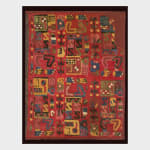Huari Culture 100 AD-1200 AD
21 x 23 in
The iconography on this textile segment is unique as testimony to the virtuosity of Andean artists' skills and creative accomplishments. It depict rows of staff-bearing figures, wherein the figures reverse direction in each row or from one column to the next. While they retain a few general elements of classic Huari (Wari) iconography, they differ in several features. These distinctions include the form of the plant-like staffs held by the figures, the square and diagonally colored teeth of the figures, the nose line form, the quartered eyes with alternating colors, the backward-facing feet, the treatment of the thumb on the hands holding the staffs, the alternation of the figures' direction within the panel, and the backward S/Z motifs on the figures' tunics, among other aspects.
Structurally, patterning by allover supplemental wefts on a ground is not observed in Wari textiles. The original warp lengths cannot be determined from what remains of the original panels; however, the original loom width is evident on both panels at 23 inches. This loom width is not characteristic of Wari tapestry tunics.



